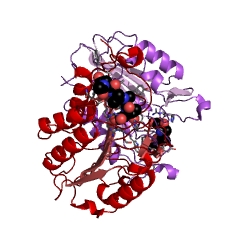| Synonyms |
apopain, C14.003, Cas-3, CASP-3, CASP3, caspase 3, caspase-3, CPP-32, CPP32, CPP32/apopain, cystein aspartic-specific protease-3, cysteine aspartic acid-specific protease, cysteine protease CPP32, DEVDase, IRP, Lyccasp3, More, SBTc-3, SCA-1, SREBP cleavage activity 1, Yama protein, Yama/CPP32, ZCASP3 |
| Comments |
Caspase-3 is an effector/executioner caspase, as are caspase-6 (EC?3.4.22.59) and caspase-7 (EC?3.4.22.60) [5]. These caspases are responsible for the proteolysis of the majority of cellular polypeptides, [e.g. poly(ADP-ribose) polymerase (PARP)], which leads to the apoptotic phenotype [3,5]. Procaspase-3 can be activated by caspase-1 (EC?3.4.22.36), caspase-8 (EC?3.4.22.61), caspase-9 (EC?3.4.22.62) and caspase-10 (EC?3.4.22.63) as well as by the serine protease granzyme B [1]. Caspase-3 can activate procaspase-2 (EC?3.4.22.55) [2]. Activation occurs by inter-domain cleavage followed by removal of the N-terminal prodomain [6]. While Asp-Glu-(Val/Ile)-Asp is thought to be the preferred cleavage sequence, the enzyme can accommodate different residues at P2 and P3 of the substrate [4]. Like caspase-2, a hydrophobic residue at P5 of caspase-3 leads to more efficient hydrolysis, e.g. (Val/Leu)-Asp-Val-Ala-Asp©à is a better substrate than Asp-Val-Ala-Asp©à. This is not the case for caspase-7 [4]. Belongs in peptidase family?C14. |


